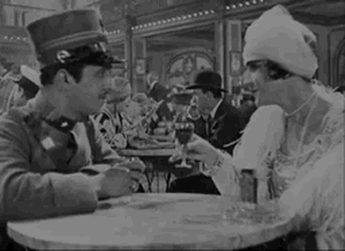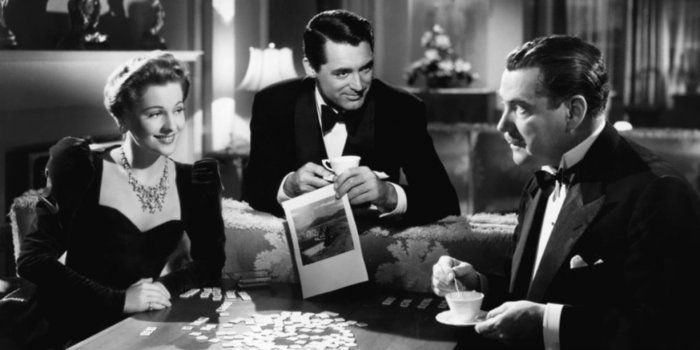I started my resolution to watch 50 movies made before 1950 in 2018 in March. While I’d already watched a couple of qualifying movies, I was still several movies behind for a good portion of the year. For progress so far: [Part I | Part II | Part III | Part IV | Part V] After a strong showing during the Six Weeks of Halloween horror movie marathon, I had made up that shortfall and then some. This past week, I officially hit 50 films made before 1950. I will definitely see a few more before year’s end; if nothing else, I will definitely be watching <a href="Miracle on 34th Street“>Miracle on 34th Street and probably It’s a Wonderful Life (both movies I’ve seen before, which I was trying to avoid, but still). Indeed, this has been something of a banner year for my movie viewing, and not just for older movies. But I digress! Let’s take a look at the films that brought me to 50:
- Wings (1927) – While technically the first Oscar winning movie, Wings does tend to get overshadowed by F.W. Murnau’s classic Sunrise (which won the defunct “Best Unique and Artistic Picture” award). Wings is certainly a more conventional movie and it’s overly sentimental and corny as hell, but it does have a lot going for it. It tells the story of two pilots who are in love with the same woman, and another woman who’s in love with one of the pilots. Off at war, the two pilots become good friends until the love triangle is revealed, which heightens tensions among the two. Again, super corny love story here (a clear precursor to Michael Bay’s Pearl Harbor, which mostly lifts the love triangle element whole, right down to one pilot being presumed dead), but it’s hard to fault it for that. The aerial combat sequences are still quite effective, even 90+ years later, with some real eye opening sequences and breathtaking shots. Even some of the more mundane bits are great, such as the tracking shot through the tables at a nightclub (a shot that obviously inspired Rian Johnson’s similar zoom through the casino in The Last Jedi).

Clocking in at 141 minutes, it’s perhaps overlong, but it never really drags and is actually paced quite well. It might not be the classic that Sunrise is, but few films are, and this is one of the better silent films I’ve seen. ***
- Ramrod (1947) – Strange little mashup of Western and Noir tropes starring Joel McCrea and Veronica Lake (a sorta reunion of the leads from Sullivan’s Travels) and directed by the famously eyepatched Andre De Toth. Lake stars as the widow of a rancher who died in a sheep vs cattle feud. She vows to spurn the advances of the local sadistic and corrupt ranchers and keep her ranch going with the help of her “ramrod” (ranch hand), who has motivations of his own. Or something like that. It’s actually pretty weirdly paced and filled with awkward exposition punctuated by the usual western tropes and noir-esque twists and turns. It moves in fits and starts, but it has an interesting combination of the moody, murky morals of noir films with the western’s tendency to punctuate boring riding and climbing sequences with shootouts and other action beats. The characters, perhaps due to excellent performances, are more complex than the usual western or noir programmer would be. For instance, Lake plays a sorta Femme Fatale who gets off on sending men off to die for her, but while there’s something cold and calculating about the way she does this, there’s also enough depth to show that she’s beaten down and lonely and maybe this is just her way of fighting back. It might sound like I’m down on this film, but that’s not quite it; it’s more unusual than that and it feels like it’s more than the sum of its parts (or, at the very least, a unique collection of fascinating parts). **1/2
- The Leopard Man (1943) – One of the more unsung films from Val Lewton’s RKO run, it’s clearly another case of a film that started with a sensational title that Lewton wrangled into something more complex and psychological than the title would have you believe (indeed, it almost feels like a conscious attempt to recapture the success of Cat People). At a swanky New Mexico nightclub, a dancer brings a leopard on stage as something of a publicity stunt. Naturally, the leopard promptly escapes and later in the evening, a young woman is found mauled to death. Soon, the bodies are starting to pile up as our heroes race to find the escaped cat. Despite some feints, there are no supernatural elements to this story and it ultimately turns out to be an early serial-killer story. Despite the more mundane subject matter, director Jacques Tourneur keeps the shadowy atmospherics at supernatural horror levels, making for an interesting contrast. The film also veers more towards a sorta police procedural than other Lewton joints, and that mostly works too. It does get a bit repetitive in the second act and the final twists are pretty easy to see coming, but it’s an entertaining, short feature and Tourneur keeps things moving briskly. Not top tier Lewton/Toruneur, but worth checking out. **1/2
- Heaven Can Wait (1943) – A spoiled urbanite dies and makes his way to the gates of hell, sure that his life has earned a one way ticket down. The devil, however, is not so sure, and makes the man recount his life, which we view in flashback form. It’s an interesting and playful little beginning, but the grand bulk of the movie is a sorta romantic comedy of errors that is quite entertaining, if a bit more conventional than the framing device might imply. Still, a lot of the humor still works, and the man’s surety of his guilt does indeed seem a bit misplaced. This was apparently the first film that director Ernst Lubitsch made in color, and he actually uses subtle changes in color to mirror the arc of our protagonist. Played by a young Don Ameche (who eventually puts on some aging makeup and looks remarkably like he would later in life), the performance is a good one. The film is consistently funny, displaying a dry wit with some nice ironies sprinkled throughout. Once I got to the end, I was a bit confused as to why he thought he’d deserve an eternity in hell, but hey, it makes for a happy ending, so there is that. ***
- Holiday Inn (1942) – The song White Christmas originated in a movie, but not the one that bears its name. Rather, it comes from this Bing Crosby and Fred Astaire vehicle about, well, a remote Inn that’s only open on Holidays (and features song and dance shows) and a pretty rote love triangle situation. Roger Ebert used to note the similarities between Musicals and Martial Arts action movies, saying the plots were incidental. There’s a plot, sure, but it’s all really just an excuse to get to the song and dance numbers, which are great, if that’s your thing. Except, um, for the blackface number, which doesn’t exactly play well to modern eyes (and the song itself is pretty embarrassing as well, so modern ears don’t fare any better). Still, White Christmas is the highlight and a deserved classic. Unfortunately, I’m not a particularly big musical fan, so while I can appreciate the charms of something like this (especially given charismatic performances from all three leads), it ultimately fell a little flat for me. I’m still glad I managed to cram a musical in the 50 under 50 umbrella though, so there is that, and if you’re going to watch this movie, this time of year is perfect for it… **
- Suspicion (1941) – And of course, we’ve got to finish off the resolution with another Hitchcock, who was the director I watched most often this year (at 4 films – the runner up is the relatively obscure Nick Grinde, who made three of those Boris Karloff programmers I watched during the Six Weeks of Halloween). This tale of a shy spinster type (or, uh, Hollywood’s version of such a thing, which is a gorgeous woman, only she’s wearing glasses and thus destined to be alone or something) who falls in love with and marries a famous eligible bachelor. Alas, he has a penchant for gambling and mooching, owes tons of money to various people, and consistently devises quick money schemes that are suspicious at best and sometimes downright sinister. Soon, our former-spinster begins to suspect murder is in the cards.
This is mostly just mid-list Hitchcock, an enjoyable and at times, tense affair that is pleasant to watch but ultimately can’t hold a candle to Hitch’s best works. It takes a while to get to the suspenseful bits, partly because Hitch spends an abnormal time establishing the romance (a welcome change of pace, actually, and there’s even some humor thrown in for good measure) and partly because he was probably trying to slowly build to a paranoid fever pitch of a climax, but even then, it gets a bit repetitive the second act. Still, there’s some great stuff going on in that third act. Great performances from Joan Fontaine and Cary Grant, and Hitch has some nice visual flourishes too (in particular, a scene where Grant carries a glass of milk from the kitchen up to Fontaine’s bedside is brilliant and memorable). The ending has a weird feel to it. There’s a sorta twist, but it almost feels like Hitch was held back from a further, darker twist. I don’t mind it, but I suspect some would find it a bit implausible. As usual, even mid-list Hitch is usually a step above its contemporaries, and that’s probably the case here too. Not where I’d recommend you start with Hitch, but it’s a decent flick. ***
So there you have it! 50 movies made before 1950. I will most likely be doing a general overview of my year in movies soon, and will include some thoughts for this resolution in that. I found the exercise quite rewarding, and am trying to think of ways to retool it for next year as well…
